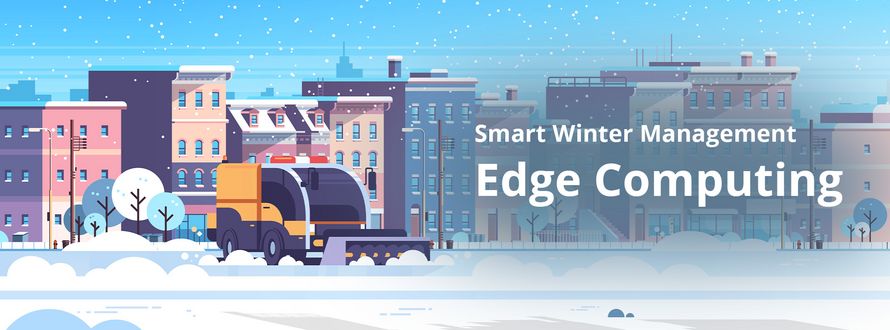
Smart and sustainable Winter Management with Edge Computing
– PikeOS, Energy & Environment, Industrial Automation, IoTWinter maintenance services are essential for ensuring the safety and functionality of cities during the harshest months of the year. Traditionally reliant on human labor, fleets of vehicles, and chemical de-icing agents, these services often face inefficiencies in resource allocation, logistical planning, and environmental sustainability. Modern technologies, including Edge Computing, autonomous systems, real-time operating systems (RTOS), and advanced sensor networks, can redefine how winter services operate. This transformation is not just about improving efficiency but also about achieving sustainability, scalability, and resilience in urban ecosystems.
Challenges of Winter Maintenance: An overlooked Urban Engineering Problem
The core challenges of winter maintenance lie in its unpredictability and resource-intensive nature. Sudden weather changes, such as unanticipated snowfall or freezing rain, can create hazardous road conditions within minutes, requiring immediate action. Cities must allocate limited resources—snowplows, salt spreaders, and labor—effectively across vast areas, often without precise data on where intervention is most needed. This often leads to over-application of de-icing materials, contributing to environmental degradation through salt runoff, while leaving some areas underserved.
In addition, the manual methods of monitoring road and weather conditions are inherently reactive, leaving local governments vulnerable to delays in response. The need for a real-time, automated, and efficient system to address these challenges has never been more apparent.
Edge Computing and Sensor Networks: The Core of Smart Winter Services
Edge Computing and sensor networks are foundational technologies for the digital transformation of winter services. Various sensors spread in city areas and embedded in builings, road surfaces, bridges, and vehicles collect real-time data on critical parameters such as road temperature, surface moisture, and snow accumulation. This data is processed locally by Edge devices, ensuring low-latency responses to dynamic conditions.
For example, road-embedded sensors can detect the onset of ice formation and trigger automated de-icing actions only where necessary, significantly reducing the overuse of salt. Snowplows and salt spreaders equipped with GPS and Edge Computing units can optimize their routes dynamically based on real-time road condition data, cutting down on fuel consumption and ensuring rapid deployment to priority areas.
The low-latency nature of Edge Computing enables immediate decision-making. Instead of waiting for centralized Cloud servers to analyze data and send instructions, Edge devices process information locally, ensuring faster and more effective actions. This decentralization also enhances system resilience by reducing dependency on stable internet connections or centralized infrastructure, which can be disrupted during severe winter storms.
Autonomous Solutions: A new Paradigm for Snow Management
Autonomous systems are a game-changer for winter services, addressing labor shortages and enabling continuous operations even in extreme conditions. Self-driving snowplows, for instance, utilize LiDAR (Light Detection And Ranging), GPS (Global Positioning System), and computer vision to navigate complex urban environments, even in low visibility caused by heavy snowfall. These vehicles are capable of executing tasks such as snow clearance, salt spreading, and road condition monitoring without human intervention.
Advanced AI algorithms can enable these autonomous systems to prioritize high-traffic areas, avoid obstacles, and adapt their operations in real-time based on incoming data from sensor networks. A fleet of interconnected autonomous snowplows can collaborate, dividing tasks intelligently to maximize coverage and minimize overlap.
Autonomous systems also offer sustainability advantages. By using AI to calculate the precise amount of de-icing material required for a given area, these machines reduce environmental impact while ensuring optimal road safety. Additionally, their ability to operate continuously without rest ensures that roads remain accessible, reducing delays and accidents caused by icy conditions.
Real-Time Operating Systems: Guaranteeing Precision and Reliability
The integration of autonomous systems and real-time data processing into winter services requires a robust and reliable software backbone. Real-time operating systems (RTOS) like SYSGO’s PikeOS provide the deterministic performance and safety certifications necessary for such critical applications.
PikeOS is designed to handle concurrent tasks with precise timing guarantees, ensuring that essential operations such as collision avoidance algorithms, sensor data processing, and control of autonomous vehicles are executed reliably. Its hypervisor technology enables the safe and secure partitioning of resources, allowing multiple software functions, such as navigation, communication, and data analysis, to run on a single hardware platform without interference.
For example, an autonomous snowplow running PikeOS can simultaneously monitor its environment, communicate with a central command system, and adjust its operations based on real-time data. By ensuring strict temporal predictability, PikeOS guarantees that safety-critical operations are not delayed, even under high system loads.
A key differentiator for PikeOS is its comprehensive certification capabilities. The system is certified to meet stringent international safety standards, including ISO 26262 (functional safety for road vehicles) or IEC 61508 (functional safety for electrical and electronic systems). These certifications are vital for ensuring that autonomous systems used in winter services can operate safely in unpredictable and potentially hazardous environments.
Cybersecurity is equally critical, especially when handling sensitive data or operating in connected ecosystems prone to cyber threats. PikeOS meets standards such as Common Criteria EAL 5+ (Evaluation Assurance Level), which certifies the secure handling of information and prevention of unauthorized access. This dual focus on safety and security makes PikeOS an ideal choice for autonomous snow removal vehicles and other critical Edge systems deployed in smart cities.
Find out more: Edge-to-Cloud Platform
Edge-to-Cloud Integration: From local Decisions to strategic Insights
While Edge Computing ensures real-time responses, integrating Edge systems with Cloud platforms unlocks long-term strategic advantages. Data collected at the Edge is transmitted to centralized Cloud systems for deeper analysis, enabling cities to identify patterns, optimize strategies, and plan for future needs.
For instance, historical data on snowfall patterns and road conditions can be analyzed using machine learning models to predict the resource requirements for upcoming winters. Cities can then pre-position equipment and materials based on these predictions, reducing operational delays.
SYSGO’s Edge-to-Cloud Platform facilitates seamless integration between Edge devices and Cloud systems. The platform ensures secure data transmission, enabling municipalities to maintain control over sensitive information while leveraging the analytical capabilities of the Cloud. This integration also supports citizen engagement, allowing residents to receive real-time updates on road conditions, snowplow locations, and service schedules.
Sustainability through digital Efficiency
One of the most significant benefits of digitalizing winter services is the potential for environmental sustainability. Data-driven decisions reduce the excessive use of de-icing materials, which can harm ecosystems and corrode infrastructure. Optimized routes and autonomous vehicles reduce fuel consumption and greenhouse gas emissions, aligning with cities’ climate goals.
Additionally, targeted maintenance preserves the lifespan of roads and bridges, reducing the need for costly repairs caused by over-application of corrosive chemicals. The integration of these systems also enhances cost efficiency, enabling municipalities to do more with fewer resources while maintaining high safety standards.
Conclusion & Outlook
The digitalization of winter services is revolutionizing urban snow management, enabling cities to overcome logistical, environmental, and operational challenges. By leveraging technologies like Edge Computing, autonomous systems, RTOS such as SYSGO’s PikeOS, and Edge-to-Cloud platforms, municipalities can enhance road safety, optimize resources, and adopt more sustainable maintenance strategies.
Certifications in systems like PikeOS ensure functional reliability and compliance with international safety and security standards, building trust in autonomous solutions for winter services. These technologies maximize the efficiency of fleets, reduce downtime, and allow dynamic allocation of vehicles to priority areas using AI and real-time data insights.
Automation addresses labor shortages by enabling continuous operation in extreme conditions while minimizing the need for manual interventions. Precise, data-driven actions reduce waste, conserve fuel, and lower greenhouse gas emissions, aligning winter services with sustainability and budgetary goals.
As cities expand and climate change brings more unpredictable winters, adopting smart and efficient winter maintenance solutions becomes essential for ensuring safety, accessibility, and resilience.
Find out more: Edge-to-Cloud Platform
-
Previous
-
Next

 Twitter
Twitter LinkedIn
LinkedIn Facebook
Facebook Reddit
Reddit RSS
RSS Copy link
Copy link
